brake FIAT FIORINO 2018 Owner handbook (in English)
[x] Cancel search | Manufacturer: FIAT, Model Year: 2018, Model line: FIORINO, Model: FIAT FIORINO 2018Pages: 196, PDF Size: 4.99 MB
Page 141 of 196

PERIODIC CHECKS
Every 1,000 km or before long
journeys, check and, if necessary, top
up:
engine coolant level;
brake fluid level;
windscreen washer fluid level;
tyre inflation pressure and condition;
operation of lighting system
(headlights, direction indicators, hazard
warning lights, etc.);
operation of windscreen washer/
wiper system and positioning/wear of
rear window wiper blades.
To ensure that the vehicle is always
efficient and well maintained, it is
advisable to make sure that you carry
out the above operations regularly
(approximately every 1000 km and
every 3000 km for checking and
topping up engine oil is advisable).
DEMANDING
VEHICLE USE
If the vehicle is mostly used in one of
the following conditions:
towing a trailer or caravan;
dusty roads;
short, repeated journeys (less than
7-8 km) at sub-zero temperatures;
engine often idling or driving long
distances at low speeds or long periods
of inactivity;
the following checks must be carried
out more often than indicated in the
Scheduled Servicing Plan:
check front disc brake pad condition
and wear;
check cleanliness of bonnet and
luggage compartment locks,
cleanliness and lubrication of linkage;
visually inspect the conditions of:
engine, gearbox, transmission, pipes
and hoses (exhaust/fuel supply/brakes),
rubber parts (boots/sleeves/bushes,
etc.);
check battery charge and battery
fluid level (electrolyte);
visually inspect conditions of the
accessory drive belts;
check and, if necessary, change
engine oil and replace oil filter;
check and, if necessary, replace
pollen filter;
check and, if necessary, replace air
cleaner.
139
Page 142 of 196
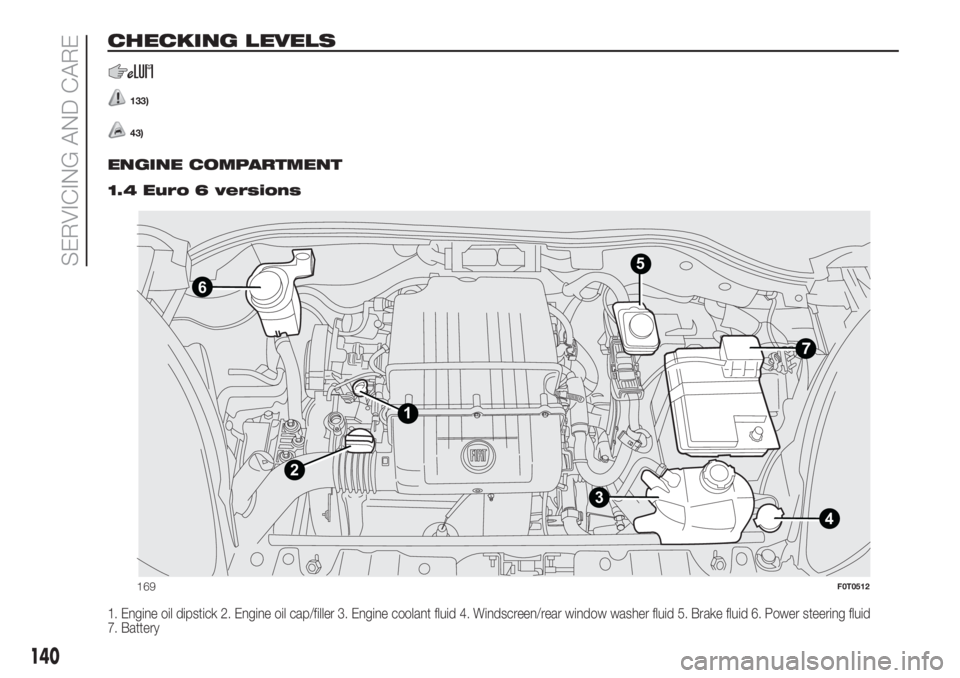
CHECKING LEVELS
133)
43).
ENGINE COMPARTMENT.
1.4 Euro 6 versions
1. Engine oil dipstick 2. Engine oil cap/filler 3. Engine coolant fluid 4. Windscreen/rear window washer fluid 5. Brake fluid 6. Power steering fluid
7. Battery
4
6
1
2
35
169F0T0512
140
SERVICING AND CARE
Page 143 of 196
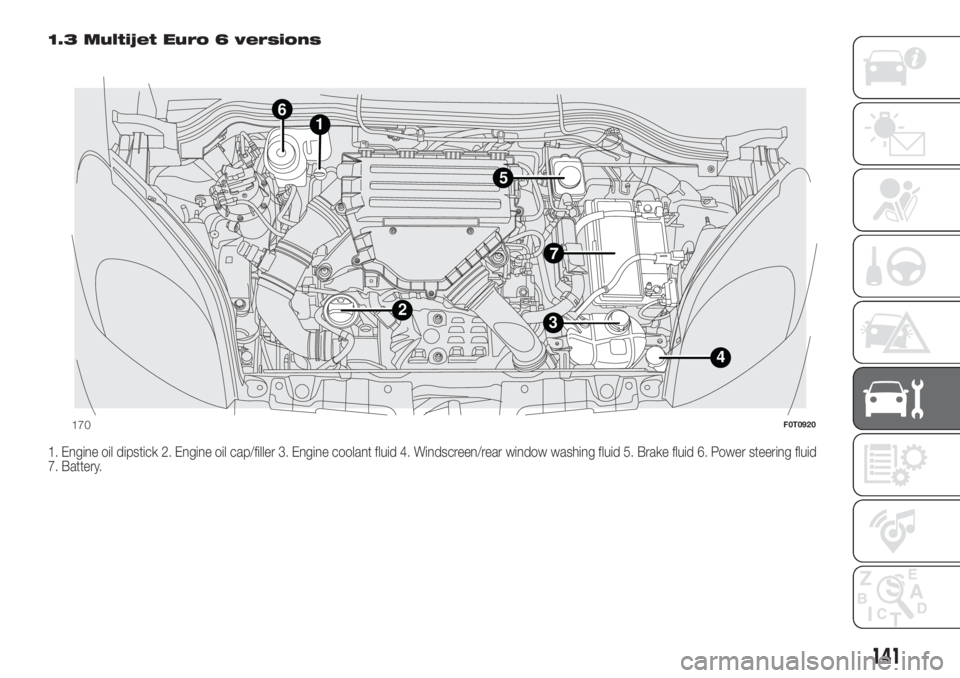
1.3 Multijet Euro 6 versions
1. Engine oil dipstick 2. Engine oil cap/filler 3. Engine coolant fluid 4. Windscreen/rear window washing fluid 5. Brake fluid 6. Power steering fluid
7. Battery.
1
32
4
5
6
170F0T0920
141
Page 144 of 196

1.4 Natural Power versions
1. Engine oil dipstick 2. Engine oil cap/filler 3. Engine coolant fluid 4. Windscreen/rear window washing fluid 5. Brake fluid 6. Power steering fluid
7. Battery
5
171F0T0374
142
SERVICING AND CARE
Page 145 of 196
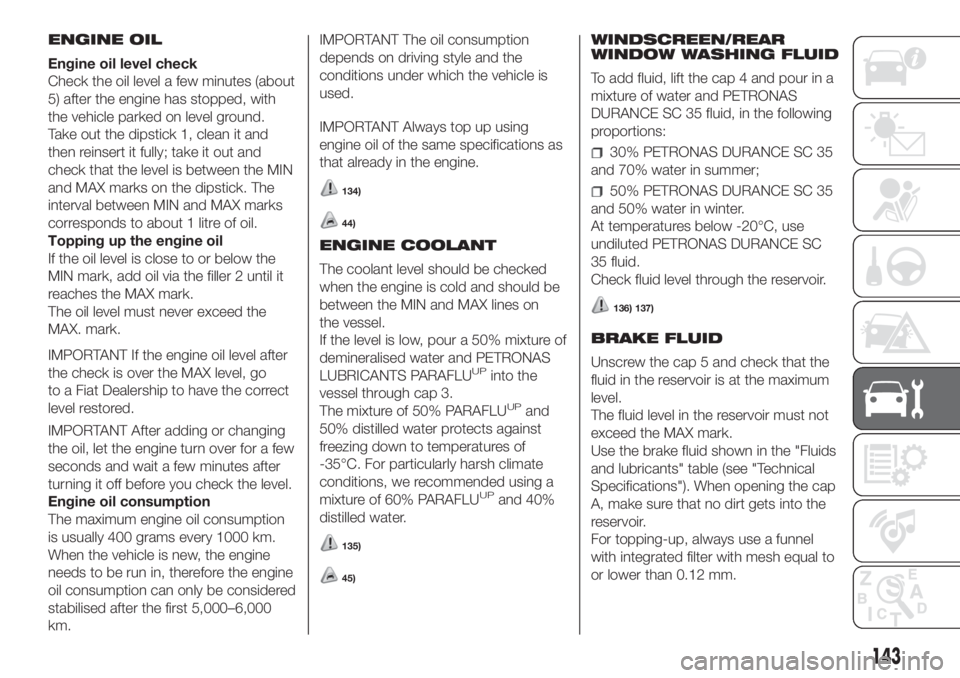
ENGINE OIL
Engine oil level check
Check the oil level a few minutes (about
5) after the engine has stopped, with
the vehicle parked on level ground.
Take out the dipstick 1, clean it and
then reinsert it fully; take it out and
check that the level is between the MIN
and MAX marks on the dipstick. The
interval between MIN and MAX marks
corresponds to about 1 litre of oil.
Topping up the engine oil
If the oil level is close to or below the
MIN mark, add oil via the filler 2 until it
reaches the MAX mark.
The oil level must never exceed the
MAX. mark.
IMPORTANT If the engine oil level after
the check is over the MAX level, go
to a Fiat Dealership to have the correct
level restored.
IMPORTANT After adding or changing
the oil, let the engine turn over for a few
seconds and wait a few minutes after
turning it off before you check the level.
Engine oil consumption
The maximum engine oil consumption
is usually 400 grams every 1000 km.
When the vehicle is new, the engine
needs to be run in, therefore the engine
oil consumption can only be considered
stabilised after the first 5,000–6,000
km.IMPORTANT The oil consumption
depends on driving style and the
conditions under which the vehicle is
used.
IMPORTANT Always top up using
engine oil of the same specifications as
that already in the engine.
134)
44)
ENGINE COOLANT
The coolant level should be checked
when the engine is cold and should be
between the MIN and MAX lines on
the vessel.
If the level is low, pour a 50% mixture of
demineralised water and PETRONAS
LUBRICANTS PARAFLU
UPinto the
vessel through cap 3.
The mixture of 50% PARAFLU
UPand
50% distilled water protects against
freezing down to temperatures of
-35°C. For particularly harsh climate
conditions, we recommended using a
mixture of 60% PARAFLU
UPand 40%
distilled water.
135)
45)
WINDSCREEN/REAR
WINDOW WASHING FLUID
To add fluid, lift the cap 4 and pour in a
mixture of water and PETRONAS
DURANCE SC 35 fluid, in the following
proportions:
30% PETRONAS DURANCE SC 35
and 70% water in summer;
50% PETRONAS DURANCE SC 35
and 50% water in winter.
At temperatures below -20°C, use
undiluted PETRONAS DURANCE SC
35 fluid.
Check fluid level through the reservoir.
136) 137)
BRAKE FLUID
Unscrew the cap 5 and check that the
fluid in the reservoir is at the maximum
level.
The fluid level in the reservoir must not
exceed the MAX mark.
Use the brake fluid shown in the "Fluids
and lubricants" table (see "Technical
Specifications"). When opening the cap
A, make sure that no dirt gets into the
reservoir.
For topping-up, always use a funnel
with integrated filter with mesh equal to
or lower than 0.12 mm.
143
Page 146 of 196
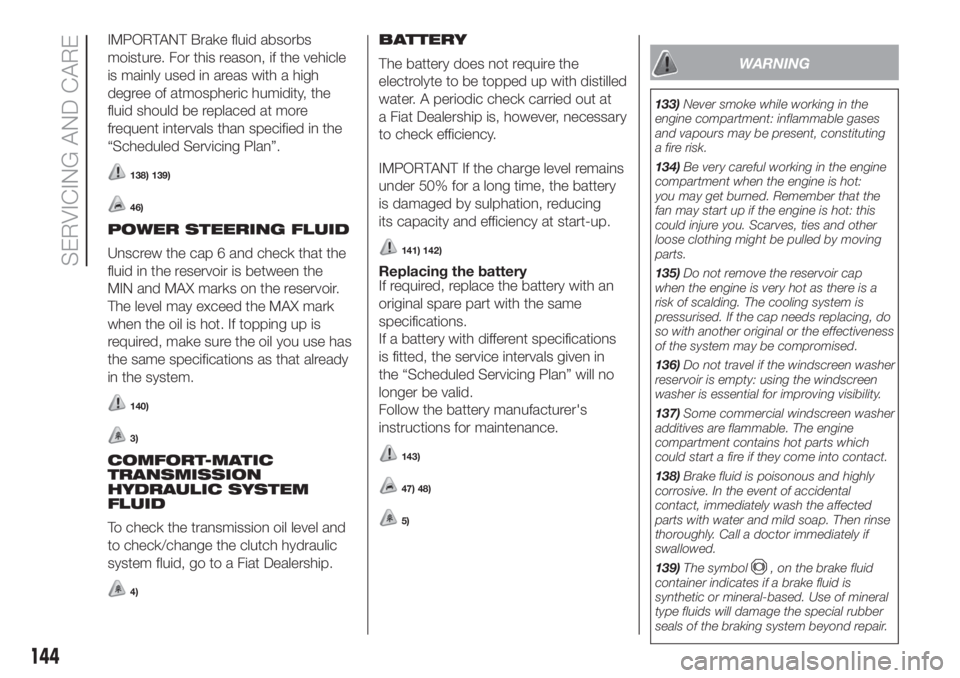
IMPORTANT Brake fluid absorbs
moisture. For this reason, if the vehicle
is mainly used in areas with a high
degree of atmospheric humidity, the
fluid should be replaced at more
frequent intervals than specified in the
“Scheduled Servicing Plan”.
138) 139)
46)
POWER STEERING FLUID
Unscrew the cap 6 and check that the
fluid in the reservoir is between the
MIN and MAX marks on the reservoir.
The level may exceed the MAX mark
when the oil is hot. If topping up is
required, make sure the oil you use has
the same specifications as that already
in the system.
140)
3)
COMFORT-MATIC
TRANSMISSION
HYDRAULIC SYSTEM
FLUID
To check the transmission oil level and
to check/change the clutch hydraulic
system fluid, go to a Fiat Dealership.
4)
BATTERY
The battery does not require the
electrolyte to be topped up with distilled
water. A periodic check carried out at
a Fiat Dealership is, however, necessary
to check efficiency.
IMPORTANT If the charge level remains
under 50% for a long time, the battery
is damaged by sulphation, reducing
its capacity and efficiency at start-up.
141) 142)
Replacing the battery
If required, replace the battery with an
original spare part with the same
specifications.
If a battery with different specifications
is fitted, the service intervals given in
the “Scheduled Servicing Plan” will no
longer be valid.
Follow the battery manufacturer's
instructions for maintenance.
143)
47) 48)
5)
WARNING
133)Never smoke while working in the
engine compartment: inflammable gases
and vapours may be present, constituting
a fire risk.
134)Be very careful working in the engine
compartment when the engine is hot:
you may get burned. Remember that the
fan may start up if the engine is hot: this
could injure you. Scarves, ties and other
loose clothing might be pulled by moving
parts.
135)Do not remove the reservoir cap
when the engine is very hot as there is a
risk of scalding. The cooling system is
pressurised. If the cap needs replacing, do
so with another original or the effectiveness
of the system may be compromised.
136)Do not travel if the windscreen washer
reservoir is empty: using the windscreen
washer is essential for improving visibility.
137)Some commercial windscreen washer
additives are flammable. The engine
compartment contains hot parts which
could start a fire if they come into contact.
138)Brake fluid is poisonous and highly
corrosive. In the event of accidental
contact, immediately wash the affected
parts with water and mild soap. Then rinse
thoroughly. Call a doctor immediately if
swallowed.
139)The symbol
, on the brake fluid
container indicates if a brake fluid is
synthetic or mineralbased. Use of mineral
type fluids will damage the special rubber
seals of the braking system beyond repair.
144
SERVICING AND CARE
Page 147 of 196
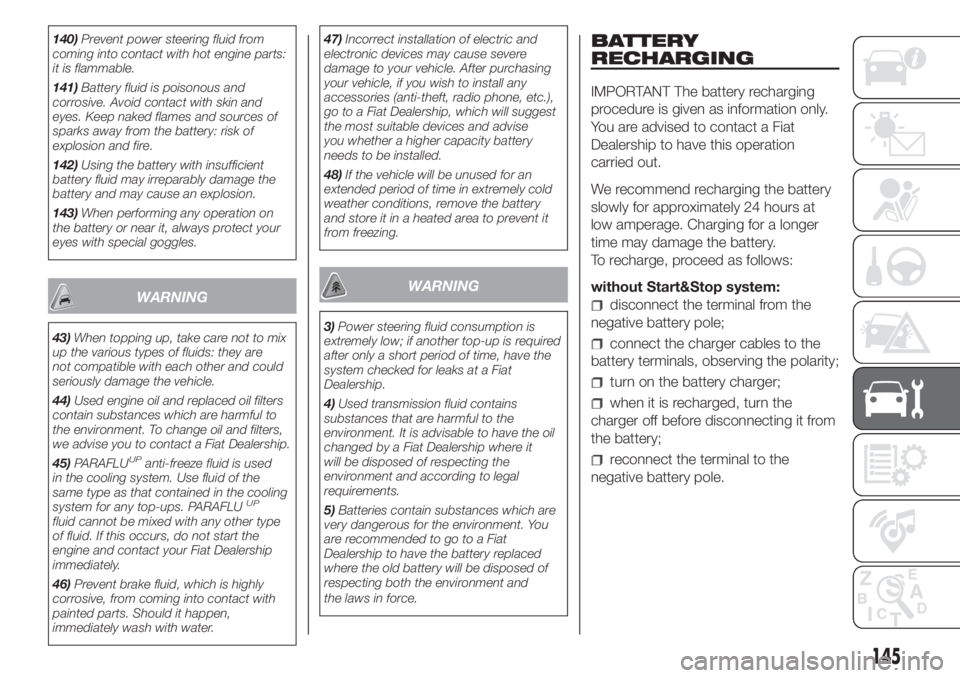
140)Prevent power steering fluid from
coming into contact with hot engine parts:
it is flammable.
141)Battery fluid is poisonous and
corrosive. Avoid contact with skin and
eyes. Keep naked flames and sources of
sparks away from the battery: risk of
explosion and fire.
142)Using the battery with insufficient
battery fluid may irreparably damage the
battery and may cause an explosion.
143)When performing any operation on
the battery or near it, always protect your
eyes with special goggles.
WARNING
43)When topping up, take care not to mix
up the various types of fluids: they are
not compatible with each other and could
seriously damage the vehicle.
44)Used engine oil and replaced oil filters
contain substances which are harmful to
the environment. To change oil and filters,
we advise you to contact a Fiat Dealership.
45)PARAFLU
UPanti-freeze fluid is used
in the cooling system. Use fluid of the
same type as that contained in the cooling
system for any top-ups. PARAFLU
UP
fluid cannot be mixed with any other type
of fluid. If this occurs, do not start the
engine and contact your Fiat Dealership
immediately.
46)Prevent brake fluid, which is highly
corrosive, from coming into contact with
painted parts. Should it happen,
immediately wash with water.47)Incorrect installation of electric and
electronic devices may cause severe
damage to your vehicle. After purchasing
your vehicle, if you wish to install any
accessories (anti-theft, radio phone, etc.),
go to a Fiat Dealership, which will suggest
the most suitable devices and advise
you whether a higher capacity battery
needs to be installed.
48)If the vehicle will be unused for an
extended period of time in extremely cold
weather conditions, remove the battery
and store it in a heated area to prevent it
from freezing.
WARNING
3)Power steering fluid consumption is
extremely low; if another top-up is required
after only a short period of time, have the
system checked for leaks at a Fiat
Dealership.
4)Used transmission fluid contains
substances that are harmful to the
environment. It is advisable to have the oil
changed by a Fiat Dealership where it
will be disposed of respecting the
environment and according to legal
requirements.
5)Batteries contain substances which are
very dangerous for the environment. You
are recommended to go to a Fiat
Dealership to have the battery replaced
where the old battery will be disposed of
respecting both the environment and
the laws in force.
BATTERY
RECHARGING
IMPORTANT The battery recharging
procedure is given as information only.
You are advised to contact a Fiat
Dealership to have this operation
carried out.
We recommend recharging the battery
slowly for approximately 24 hours at
low amperage. Charging for a longer
time may damage the battery.
To recharge, proceed as follows:
without Start&Stop system:
disconnect the terminal from the
negative battery pole;
connect the charger cables to the
battery terminals, observing the polarity;
turn on the battery charger;
when it is recharged, turn the
charger off before disconnecting it from
the battery;
reconnect the terminal to the
negative battery pole.
145
Page 162 of 196
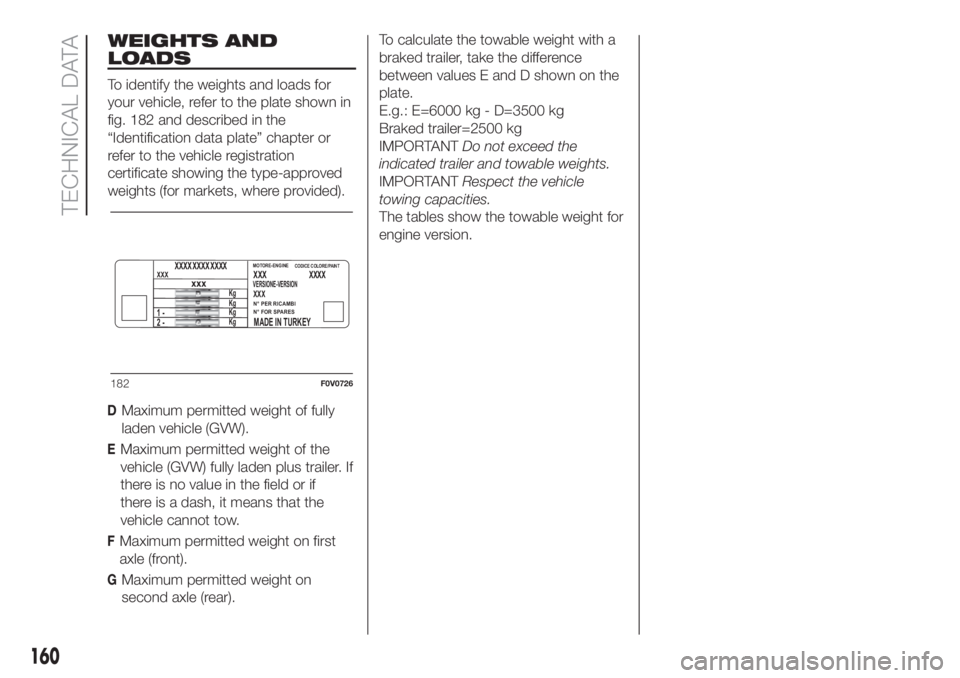
WEIGHTS AND
LOADS
To identify the weights and loads for
your vehicle, refer to the plate shown in
fig. 182 and described in the
“Identification data plate” chapter or
refer to the vehicle registration
certificate showing the type-approved
weights (for markets, where provided).
160
TECHNICAL DATA
DMaximum permitted weight of fully
laden vehicle (GVW).
EMaximum permitted weight of the
vehicle (GVW) fully laden plus trailer. If
there is no value in the field or if
there is a dash, it means that the
vehicle cannot tow.
FMaximum permitted weight on first
axle (front).
GMaximum permitted weight on
second axle (rear).
XXXXXX
XXXVERSIONE-VERSION
N° PER RICAMBI
N° FOR SPARES
MADE IN TURKEY
XXXXxxx
MOTORE-ENGINECODICE COLORE/PAINT
2 - 1 -
Kg
Kg
Kg
Kg
XXXX XXXX XXXX
182F0V0726
To calculate the towable weight with a
braked trailer, take the difference
between values E and D shown on the
plate.
E.g.: E=6000 kg - D=3500 kg
Braked trailer=2500 kg
IMPORTANTDo not exceed the
indicated trailer and towable weights.
IMPORTANTRespect the vehicle
towing capacities.
The tables show the towable weight for
engine version.
Page 163 of 196
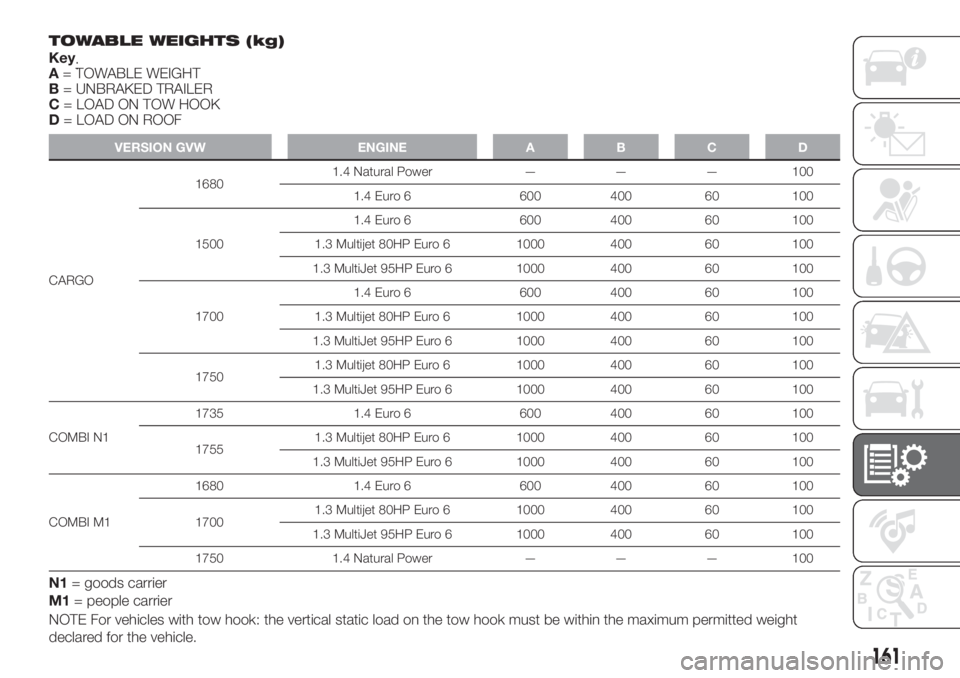
161
TOWABLE WEIGHTS (kg)
Key
:
A= TOWABLE WEIGHT
B= UNBRAKED TRAILER
C= LOAD ON TOW HOOK
D= LOAD ON ROOF
VERSION GVW ENGINE A B C D
CARGO16801.4 Natural Power — — — 100
1.4 Euro 6 600 400 60 100
15001.4 Euro 6 600 400 60 100
1.3 Multijet 80HP Euro 6 1000 400 60 100
1.3 MultiJet 95HP Euro 6 1000 400 60 100
17001.4 Euro 6 600 400 60 100
1.3 Multijet 80HP Euro 6 1000 400 60 100
1.3 MultiJet 95HP Euro 6 1000 400 60 100
17501.3 Multijet 80HP Euro 6 1000 400 60 100
1.3 MultiJet 95HP Euro 6 1000 400 60 100
COMBI N11735 1.4 Euro 6 600 400 60 100
17551.3 Multijet 80HP Euro 6 1000 400 60 100
1.3 MultiJet 95HP Euro 6 1000 400 60 100
COMBI M11680 1.4 Euro 6 600 400 60 100
17001.3 Multijet 80HP Euro 6 1000 400 60 100
1.3 MultiJet 95HP Euro 6 1000 400 60 100
1750 1.4 Natural Power — — — 100
N1= goods carrier
M1= people carrier
NOTE For vehicles with tow hook: the vertical static load on the tow hook must be within the maximum permitted weight
declared for the vehicle.
Page 164 of 196
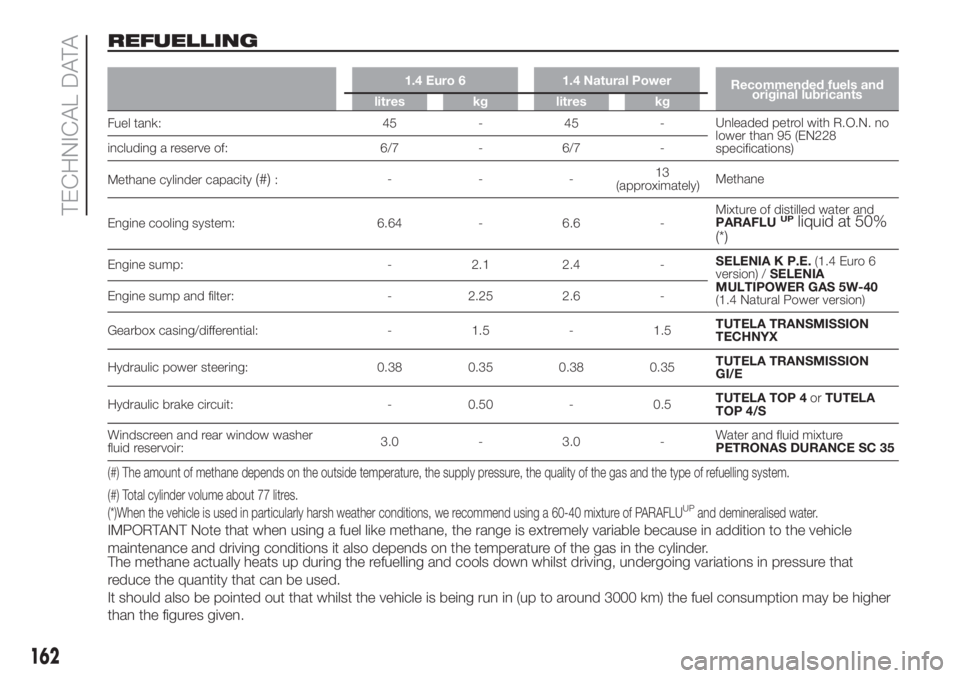
REFUELLING
1.4 Euro 6 1.4 Natural Power
Recommended fuels and
original lubricants
litres kg litres kg
Fuel tank: 45 - 45 -Unleaded petrol with R.O.N. no
lower than 95 (EN228
specifications) including a reserve of: 6/7 - 6/7 -
Methane cylinder capacity
(#):---13
(approximately)Methane
Engine cooling system: 6.64 - 6.6 -Mixture of distilled water and
PARAFLU
UPliquid at 50%(*)
Engine sump: - 2.1 2.4 -SELENIA K P.E.(1.4 Euro 6
version) /SELENIA
MULTIPOWER GAS 5W-40
(1.4 Natural Power version) Engine sump and filter: - 2.25 2.6 -
Gearbox casing/differential: - 1.5 - 1.5TUTELA TRANSMISSION
TECHNYX
Hydraulic power steering: 0.38 0.35 0.38 0.35TUTELA TRANSMISSION
GI/E
Hydraulic brake circuit: - 0.50 - 0.5TUTELA TOP 4orTUTELA
TOP 4/S
Windscreen and rear window washer
fluid reservoir:3.0 - 3.0 -Water and fluid mixture
PETRONAS DURANCE SC 35
(#) The amount of methane depends on the outside temperature, the supply pressure, the quality of the gas and the type of refuelling system.
(#) Total cylinder volume about 77 litres.
(*)When the vehicle is used in particularly harsh weather conditions, we recommend using a 60-40 mixture of PARAFLU
UPand demineralised water.
IMPORTANT Note that when using a fuel like methane, the range is extremely variable because in addition to the vehicle
maintenance and driving conditions it also depends on the temperature of the gas in the cylinder.
The methane actually heats up during the refuelling and cools down whilst driving, undergoing variations in pressure that
reduce the quantity that can be used.
It should also be pointed out that whilst the vehicle is being run in (up to around 3000 km) the fuel consumption may be higher
than the figures given.
162
TECHNICAL DATA